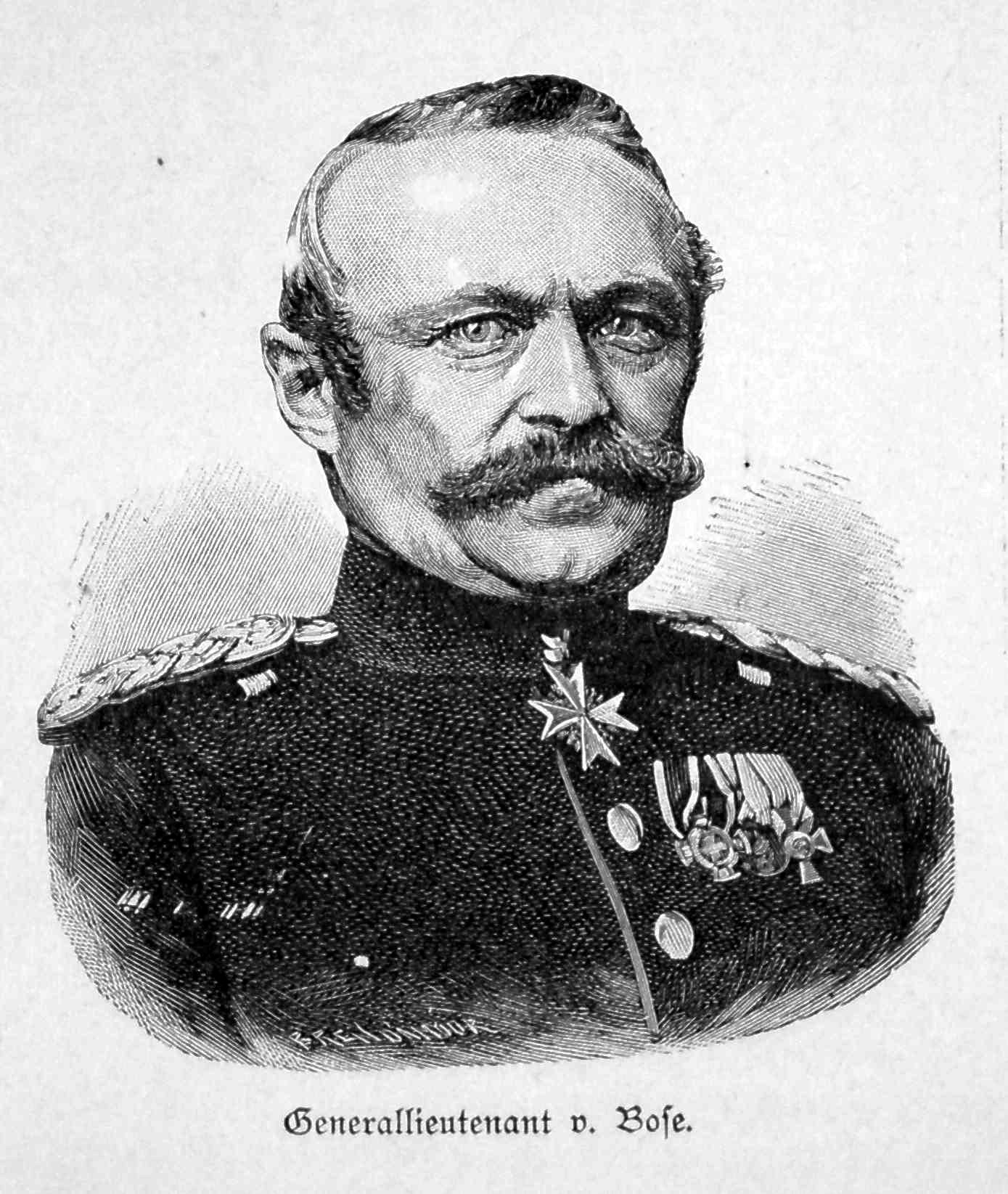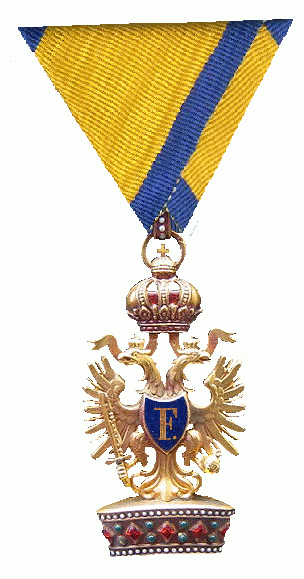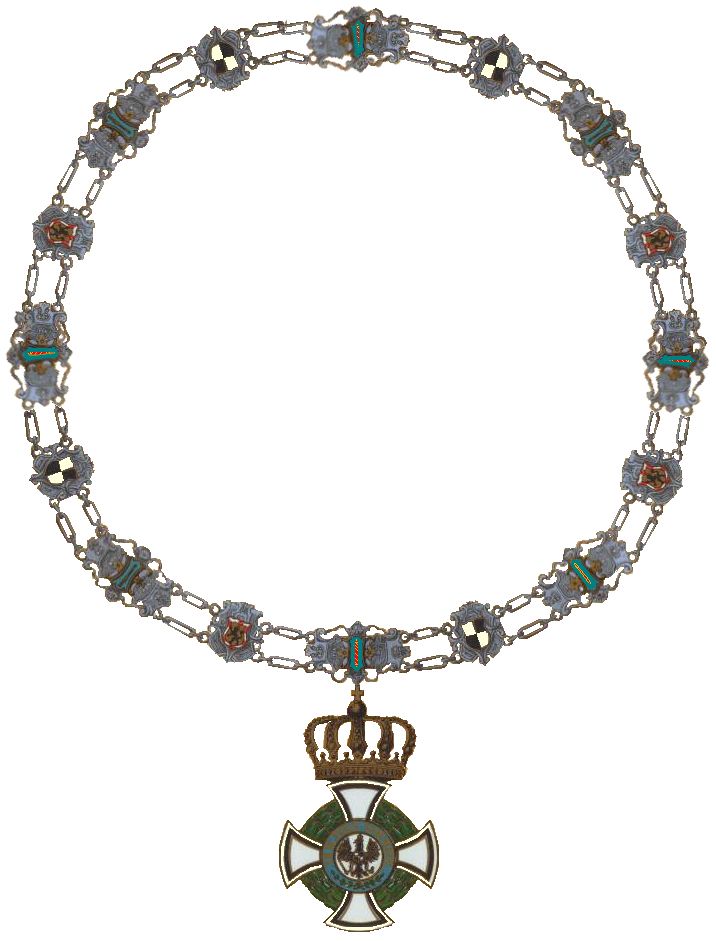|
Julius Von Bose
Friedrich Julius Wilhelm Graf von Bose (12 September 1809 – 22 July 1894) was a Prussian general who commanded the Prussian XI Corps during the Franco-Prussian War. In 1821 Bose was a page boy at the court of Weimar. Bose entered the Prussian 26th Infantry Regiment in 1826. He became an officer in 1829. From 1832 to 1835 he studied at the Prussian Military Academy, which was a prerequisite to joining the General Staff. Bose served as an adjutant in various positions from 1835 to 1852. In 1853 he became a major on the General Staff. In 1858 Bose became chief of staff of the IV Corps. In 1860 he was promoted to colonel and given command of a regiment of infantry. A year later he was given a position in the Prussian war ministry. Bose was promoted to major general in 1864. During the Austro-Prussian War Bose commanded the 15th Infantry Brigade, with which he distinguished himself at Podol, Münchengrätz and Sadowa. At the end of the war Bose was promoted to lieutenant-general ... [...More Info...] [...Related Items...] OR: [Wikipedia] [Google] [Baidu] |
Sangerhausen
Sangerhausen () is a town in Saxony-Anhalt, central Germany, capital of the district of Mansfeld-Südharz. It is situated southeast of the Harz, approx. east of Nordhausen, and west of Halle (Saale). About 26,000 people live in Sangerhausen (2020). History Sangerhausen is one of the oldest towns in the historical region of Saxony-Anhalt, being first mentioned in a document created between 780 and 802 in Fulda Abbey. Sangerhausen is mentioned as the tithable place ''Sangerhus'' in Friesenfeld in the Hersfeld Tithe Register, created between 881 and 899. It is mentioned in a document of 991 as appertaining to the estates of the emperor, as part of Memleben Abbey. By marriage it passed to the landgrave of Thuringia, and after 1056 it formed for a while an independent country. Having been again part of Thuringia, it fell in 1249 to Meissen, and in 1291 to Brandenburg. In 1372 it passed to the Electorate of Saxony and formed a portion of that territory until 1815, when it ... [...More Info...] [...Related Items...] OR: [Wikipedia] [Google] [Baidu] |
Battle Of Podol
The Battle of Podol was a minor engagement in the opening days of the Battle of Königgrätz, Königgrätz campaign of the Austro-Prussian War in Bohemia on 26 and 27 June 1866. The battle took place in modern-day Svijany between troops of the Prussian First Army (Austro-Prussian War), First Army (Julius von Bose's 15th Brigade) and elements of Eduard Clam-Gallas' Austrian I Corps. Background On 24 June Prince Albert, King of Saxony, Albert of Saxony had been placed in overall command of Austro-Saxon forces along the Jizera (river), Iser river. Albert's troops joined up with Eduard Clam-Gallas' I Corps near Münchengrätz. On 26 June, Albert suggested that they occupy Turnov, Turnau to the north to cover their flank. Clam-Gallas disagreed and nothing was done until the afternoon, when Albert received word of the Prussian occupation of Turnau at the same time as an order arrived from Ludwig von Benedek, the commander of the Austrian Army of the North, to hold Turnau and Müncheng ... [...More Info...] [...Related Items...] OR: [Wikipedia] [Google] [Baidu] |
Order Of Leopold (Austria)
The Austrian Imperial Order of Leopold () () was founded by Franz I of Austria on 8 January 1808. The order's statutes stipulated only three grades: Grand Cross, Commander and Knight. During the war, in common with the other Austrian Empire, Austrian and later Austria-Hungary, Austro-Hungarian decorations, war decoration (represented by a laurel wreath) and/or swords were added to reward meritorious service and bravery in the face of the enemy. An Imperial Decree of 1 February 1901 ordered that in future, the senior grade would be split into two separate awards. From then onwards, there were four ranks: Grand Cross, First Class, Commander, Knight. Until 18 July 1884, the award of the order also entitled the recipient, if he was not already of that standing, to be raised to the following appointments and/or ranks of the nobility: *Grand Cross: Privy Councillor *Commander: Baron *Knight: Ritter Insignia Both the Grand Cross and the First Class members of the Order wore (on for ... [...More Info...] [...Related Items...] OR: [Wikipedia] [Google] [Baidu] |
Order Of The Iron Crown (Austria)
The Imperial Order of the Iron Crown (; ) was one of the highest orders of merit in the Austrian Empire and Austria-Hungary until 1918. It was founded in 1815 by Emperor Franz I of Austria as a re-establishment of the original Order of the Iron Crown, which previously had been an order of the Napoleonic Kingdom of Italy. The order had three classes and, until 1884, all classes conferred automatic hereditary ennoblement. The third class conferred the rank of ''Ritter'', the second class conferred the rank of ''Baron'', and the first class conferred the title of Privy Councillor, the style of Excellency and the right to attend court. According to the order's statutes, only a limited number of members throughout the empire were allowed at any given time. The maximum number of 1st class knights was 20, for the 2nd class it was 30 and for the 3rd class 50, limiting the total number of members to 100 at any given time. History The Holy Roman Empire, ruled by the Habsburg dynasty, ga ... [...More Info...] [...Related Items...] OR: [Wikipedia] [Google] [Baidu] |
Military Merit Order (Württemberg)
The Military Merit Order (''Militärverdienstorden'') was a military order of the Kingdom of Württemberg, which joined the German Empire in 1871. The order was one of the older military orders of the states of the German Empire. It was founded on 11 February 1759 by Karl Eugen, Duke of Württemberg as the ''Militär-Carls-Orden'', and was renamed the ''Militärverdienstorden'' on 11 November 1806 by King Friedrich I. The order underwent several more revisions over the course of the 19th and early 20th centuries. It became obsolete with the fall of the Württemberg monarchy in the wake of Germany's defeat in World War I. Classes The order came in three classes: * Grand Cross (''Großkreuz'') * Commander's Cross (''Kommandeurkreuz'') and * Knight's Cross (''Ritterkreuz''). Generally, the rank of the recipient determined which grade he would receive. Between 1799 and 1919, there were an estimated 95 awards of the Grand Cross, 214 of the Commander's Cross, and 3,128 of the Kni ... [...More Info...] [...Related Items...] OR: [Wikipedia] [Google] [Baidu] |
Order Of The Crown (Württemberg)
The Order of the Württemberg Crown (''Orden der Württembergischen Krone'') was an order of chivalry in Württemberg. History First established in 1702 as the (Hunting Order of St Hubert), in 1807 it was renamed the (Knightly Order of the Golden Eagle) by Frederick I of Württemberg, Frederick I, and on 23 September 1818 renewed and restructured (at the same time as the civil orders) by William I of Württemberg, William I as the Order of the Württemberg Crown with (initially) 3 classes (grand cross, commander (order), commander, knight). In 1889 and 1892, the order was expanded and changed. Its motto reads ' ('fearless and loyal'). Until 1913 the higher orders were restricted to the nobility. In descending order, its ranks were: # Knight Grand Cross, Special Class (for sovereigns) # Knight Grand Cross # Knight Commander (since 1889) # Commander # Cross of Honour (; since 1892) # Knight (since 1892 with golden lions, and since 1864 also with a crown, as a special honour) # ... [...More Info...] [...Related Items...] OR: [Wikipedia] [Google] [Baidu] |
Order Of Philip The Magnanimous
The Order of Merit of Philip the Magnanimous () was an order of chivalry established by Louis II, Grand Duke of Hesse on 1 May 1840, the name day of Philip I, Landgrave of Hesse, in his honour to award extraordinary military or civil merit. It was the second-highest order of the Grand Duchy of Hesse before 1876, when it was displaced to third by the revived Order of the Golden Lion, the former paramount order of the Electorate of Hesse. After the First World War and the fall of the German monarchies, the order—along with all other grand ducal decorations—was formally abolished in 1919. Overview The order was initially divided into four grades: Grand Cross, Commanders 1st and 2nd classes, and knight. On the anniversary of its founding in 1849, a new class was created, the Silver Cross, with the introduction of crossed swords in gold or silver for the class. From 10 November 1859 the knight class was further divided into two grades, 1st and 2nd classes. In 1876, the ... [...More Info...] [...Related Items...] OR: [Wikipedia] [Google] [Baidu] |
House Order Of Hohenzollern
The House Order of Hohenzollern ( or ') was a dynastic order of knighthood of the House of Hohenzollern awarded to military commissioned officers and civilians of comparable status. Associated with the various versions of the order were crosses and medals which could be awarded to lower-ranking soldiers and civilians. History The Princely House Order of Hohenzollern originated in 1841, by joint decree of Prince Konstantin of and Prince Karl Anton of . These two principalities in southern Germany were Catholic collateral lines of the House of Hohenzollern, cousins to the Protestant ruling house of Prussia. On 23 August 1851, after the two principalities had been annexed by Prussia, the order was adopted by the Prussian branch of the house. Also, although the two principalities had become an administrative region of the Prussian kingdom, the princely lines continued to award the order as a house order. The Prussian version was then known as the Royal House Order of Hohenzollern (' ... [...More Info...] [...Related Items...] OR: [Wikipedia] [Google] [Baidu] |
Order Of The Red Eagle
The Order of the Red Eagle () was an order of chivalry of the Kingdom of Prussia. It was awarded to both military personnel and civilians, to recognize valor in combat, excellence in military leadership, long and faithful service to the kingdom, or other achievements. As with most German and other European orders, the Order of the Red Eagle could be awarded only to commissioned officers or civilians of approximately equivalent status. However, there was a medal of the order, which could be awarded to non-commissioned officers and enlisted men, lower ranking civil servants and other civilians. History The predecessor to the Order of the Red Eagle was founded on 17 November 1705, by the Margrave Georg Wilhelm of Brandenburg-Bayreuth as the '' Ordre de la Sincérité''. This soon fell into disuse but was revived in 1712 in Brandenburg-Bayreuth and again in 1734 in Brandenburg-Ansbach, where it first received the name of "Order of the Brandenburg Red Eagle". The statutes were change ... [...More Info...] [...Related Items...] OR: [Wikipedia] [Google] [Baidu] |
Order Of The Crown (Prussia)
The Royal Order of the Crown () was a Prussian order of chivalry. Instituted in 1861 as an honour equal in rank to the Order of the Red Eagle, membership could only be conferred upon commissioned officers (or civilians of approximately equivalent status), but there was a medal associated with the order which could be earned by non-commissioned officers and enlisted men. Officially the Order of the Red Eagle and the Order of the Crown were equal. Most officials did however prefer to be appointed in the older Order of the Red Eagle. The Order of the Crown was often used as an award for someone who had to be rewarded while the Prussian government did not want to use the Order of the Red Eagle. Classes The Order had six classes: *Grand Cross – wore the Grand Cross badge on a sash on the right shoulder, plus the star on the left chest; *1st Class – wore the badge on a sash on the right shoulder, plus the star on the left chest; *2nd Class – wore the badge on a necklet, plus t ... [...More Info...] [...Related Items...] OR: [Wikipedia] [Google] [Baidu] |
Johanniter Order
The Bailiwick of Brandenburg of the Chivalric Order of Saint John of the Hospital at Jerusalem (), commonly known as the Order of Saint John or the Johanniter Order (German: ''Johanniterorden''), is the German Protestant branch of the Knights Hospitaller, the oldest surviving chivalric order, which generally is considered to have been founded at Jerusalem in 1099. The Order is led by its thirty-seventh ''Herrenmeister'' ("Master of the Knights" or Grand Master), Oskar Prince of Prussia. Each of its knights, about four thousand men worldwide, is either a Knight of Justice (''Rechtsritter'') or a Knight of Honour (''Ehrenritter''). Membership in the Order is by appointment only, and individuals may not petition for admission; it is not limited to German citizens or German speakers, and knights include citizens and residents of numerous countries. Although membership is no longer limited to the nobility, as it was until 1948, the majority of knights still are drawn from this class. ... [...More Info...] [...Related Items...] OR: [Wikipedia] [Google] [Baidu] |
Kingdom Of Prussia
The Kingdom of Prussia (, ) was a German state that existed from 1701 to 1918.Marriott, J. A. R., and Charles Grant Robertson. ''The Evolution of Prussia, the Making of an Empire''. Rev. ed. Oxford: Clarendon Press, 1946. It played a significant role in the unification of Germany in 1871 and was a major constituent of the German Empire until its German Revolution of 1918–1919, dissolution in 1918. Although it took its name from the Prussia (region), region called Prussia, it was based in the Margraviate of Brandenburg. Its capital was Berlin. The list of monarchs of Prussia, kings of Prussia were from the House of Hohenzollern. The polity of Brandenburg-Prussia, predecessor of the kingdom, became a military power under Frederick William, Elector of Brandenburg, known as "The Great Elector". As a kingdom, Prussia continued its rise to power, especially during the reign of Frederick the Great, Frederick II "the Great".Horn, D. B. "The Youth of Frederick the Great 1712–30." ... [...More Info...] [...Related Items...] OR: [Wikipedia] [Google] [Baidu] |




